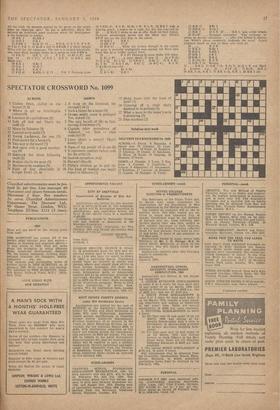Chess
By PHILIDOR
No. 159. W. A. SHINKMAN (St. John's Globe, 1888) BLACK (3 men)
WHITE (6 men) WHITE to play and mate in two moves: solu- tion next week. Solution to No. 158 (Loyd): 1 . . . P-B 4; 2 P x P e.p. 1 . . . K-K 2; 2 B x P.
. . . K-K 3 or K 4; 2 Q-K 4. Yes I know the key gave check—but it was December 27 and the composer's name was Sam Loyd: that should have been warning enough. Apologies to the experts to whom this classic would of course be very well known. This week a problem by another equally famous 'old master.'
Another major book has been added to English chess literature by the production of an English version, Modern Chess Strategy (Pitman's), of Pachman's Strategie Moderniho Sachu. The import- ant feature of the book is not to my mind the method of subdivision of the subject-matter (every- one has his own ideas on this) but the fact that the teaching is conducted by means of the analysis of over a hundred master games. In so far as it is possible to learn advanced strategy by reading about it, the best way to do so is through master games annotated by a master; for this reason if for no other you will get both instruction and pleasure from Pachman. Here is a game from the book with notes based on Pachman's.
White, PACHMAN; Black, DONNER; Opening, ENGLISH. (Rotterdam, 1955).
1 P-QB 4 P-KKt 3 2 Kt-QB 3 B-Kt 2 3 P-KKt 3 Kt-KB 3 4 B-Kt 2 0-0 5 P-K 4 P-K 4. Better, as we shall see, would be P-11 4.
6 KKt-K 2 P K-Q 3
7 0-0 Kt-Q 2 8 P-Q 3 P-KB 4
9PxP P x P. Black has carried out his opening plan but Pachman comments: '. . . the position is not favour- able to him. White .. will increase his pressure on the centre by P-KB 4 and finally' break it up by the advance P-Q 4. . . .
All the while the pressure exerted by his pieces on the centre play, an important part.' To put it differently, Black has adopted an ambitious pawn structure which his development is too backward to sustain.
10 13-1( 3 Kt-KB 3
11 -Q 2 P-13 12 Q P-KR 3 Kt-R3 47 12 . P-0 4; 13 P x P, P x P; 14 P-Q 4. P-K 5; 15 Kt-B 4 and 16 KR-QB 1 is better though White still has the advantage. The text is a tactical miscalcula- tion since Black wrongly thinks he is going to stop P-KB 4.
13 P-B 4! Q-K 1. 13 . . , P X P; 14 Kt X Pi and now 14 . . . Kt X P7; 15 R-13 3, Q-R 5; 16 11-11 2 and White wins. 14 K-11 2 Q-Kt 3 Q 15 -K 1 Kt
16 R-Q 1 K-R-Q 12 17 P-Q 41 R-KKt I. It 17 . , P-K 5; Nehmen gives IS P-KKt 4! PXP; 19 Kt x P, PXP; 20 R-R 3 with a winning attack. I expect ho is tight, but this line followed by 20 . . . Q Kt-B 3 seems to me to offer Black his best chance. Pachman interestingly points out the effect that White's MO'. has on the vital play in the centre.
le Q-B 2 B-B 3 19 QP X P PXP 20 R-Q 6! . . . White has broken through in the centre; his game is probably strategically won anyway but Black pow helps him by a further tactical error,
20 ..P P X P7 Thinking he must retake With pawn. 21 Kt x P! .a nasty shock. if now 21 . . .Q X P ch;
22 Q X Q, Kt X b; 23 KR-Q 1, R-Kt 2; 24 R X 131, Kt X II; 25 R-Q 8 eh,' R-Kt 26 B-Q 41, R X R;
27 B X Kt ch and sins. X . K Qt B X Kt
22 Li Kt ' - 2 23 R-K 1! B-Kt 2 24 R(6)-K 6! Kt-1.3 1 25 R-K 7 Q X P. 25 . . • Q-B 3; lasts rather longer, 26 RXB! . Pitchman comments: "This exchange re-
quires no precise calculation . . after {the bishop's] elimina- tion White's pieces completely dominate the scene,' Expert judgment scents so easy to those who have ill 26 . . . RXR
27 R-K 8 K-Kt 1 28 B-Q 6 R-KR 2 29 Q-K 3 P-11 5 30 Q-K 5 R-B 4
31 RXKtch! R x
32 Q-Kt 5 ch Resigns.
32 . . K-B 2; 33 Q-K 7 ch, K-Kt 3; 34 0 X R and Rleck is helpless, e.g. 34 PXP ch: 35 BXP, Q-B 2; 36 B-K 4 ch, K-B 3; 37 B-R 4 ch, K-K 3; 38 BA3 5 chi































 Previous page
Previous page